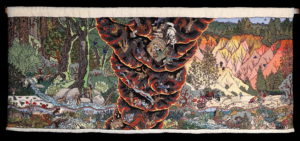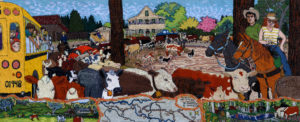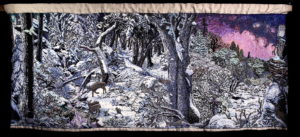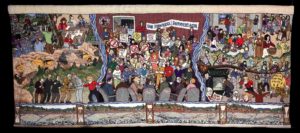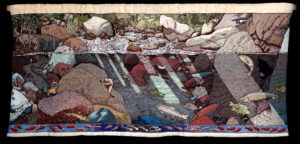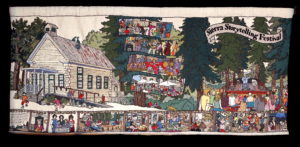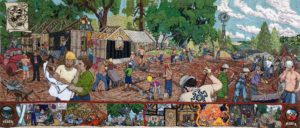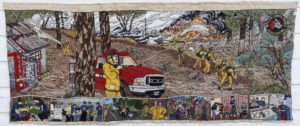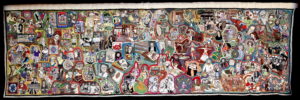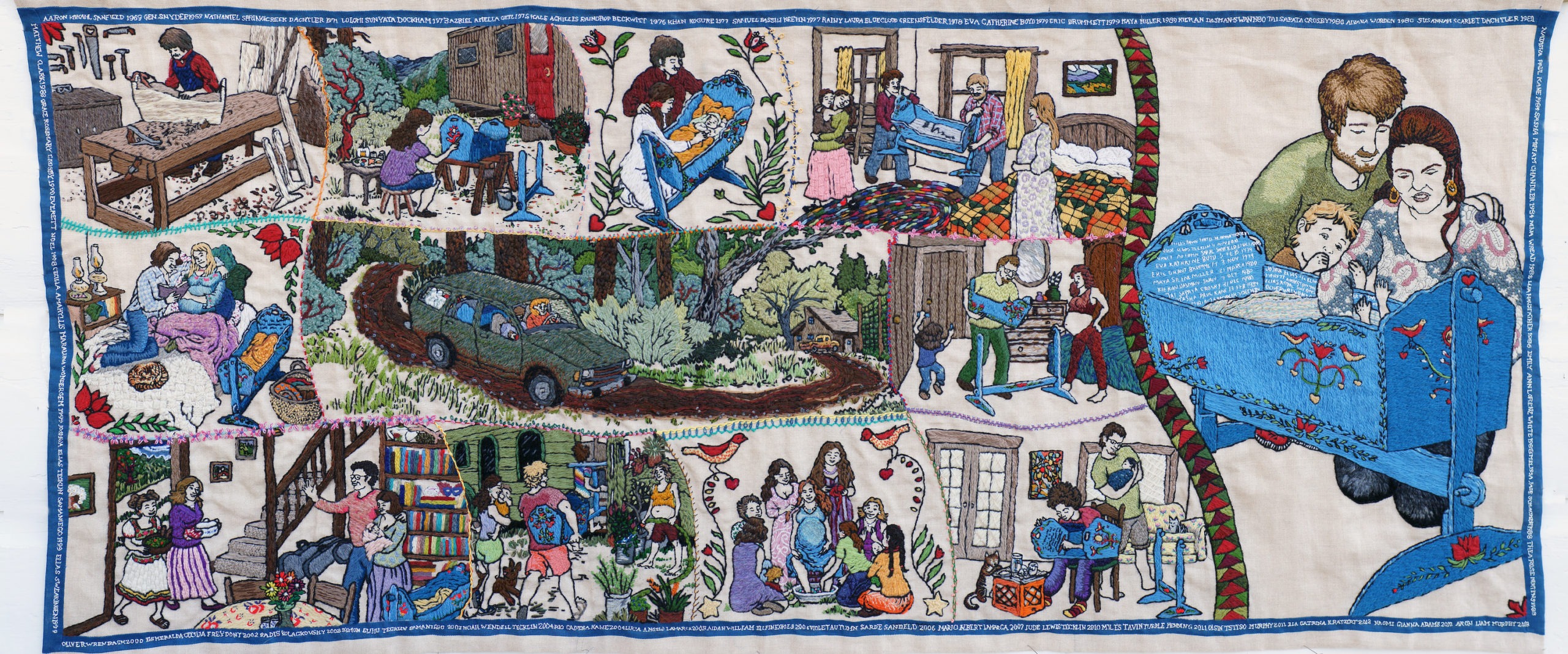Stories of the San Juan Ridge Stitched into History
Environmental awareness, and community building intertwine to create a vibrant narrative. Immerse yourself in these rich tapestries where each thread illustrates the intricate patterns of life on the San Juan Ridge.
Your Mountains
The Land Then and Now
Mining has touched a quarter of the land on the San Juan ridge. The hydraulic mining of the late 1800s had the most destructive effect. “The Land Then and Now” depicts the changes wrought by the Gold Rush – on the land, the flora, the fauna, and the people.
The Cattle Drive
The Coughlan Ranch was one of the few remaining on San Juan Ridge. Their cattle drive between Snow Tent, North Columbia and Spenceville were notorious for tying up traffic. Loose cattle often ate through neighbors’ gardens.
The Forest
The forest and the river are the heart of why Ridge dwellers live where they do. “The Forest” gives a taste of the differences in habitat from the lower elevations at 1,500 feet to the higher elevation at 5,000 feet. Over the last 50 years there has been a continuing effort to point the forest toward maturity.
Don’t Mine Our Water
The San Juan Ridge Taxpayers Association, formed in 1975, has successfully challenged repeated attempts to resume mining for gold on a 2,000- acre property located in the heart of the Ridge
The River
“The River” attempts to convey the depth of feeling the ridge community has for the Yuba River. Emphasis is on the distinctive water-scraped granite boulders and the underwater creatures living in the three forks of the Yuba River. The lower banner shows the salmon returning to health.
Homesteads and Work Parties
Artist Jennifer Rain Crosby chose eight owner-built homesteads built between 1970 and 2000. They include Robin and Arlo Acton’s home built around a large boulder, Gary Snyder’s Japanese influenced house, and Steve Sanfield’s on a steep hillside.
Our Community
North Columbia Schoolhouse
The North Columbia schoolhouse, now a center of community life. The scenes depict the origins of the Cultural Center, the Sierra Storytelling Festival, dances, art shows, the children’s Art Camp and Gary Snyder‘s hours-long reading of “Mountains and Rivers Without End.”
Building the Oak Tree School
The Oak Tree School was conceived as a community project and built with local labor and local materials. The architects wanted it to reflect the community’s ideals; the buildings clustered together yet separate in identity. One building was a replica of the N. Columbia Schoolhouse.
Volunteer Fire Department
Volunteer community members have led the North San Juan Fire Department since its founding in 1862. Volunteers have saved lives, houses, gardens, and forests from fire. They have also, responded to medical emergencies and acted to build the community through fundraisers.
Arts and Artisans
The Ridge has been fertile ground for the growth of the creative spirit. Undeterred by the constant demands of rural living, artists and artisans get the book written, the canvas stretched, the clay formed, the song sung.
Halloween Ceremony
An annual community gathering; including a Maidu welcome ritual, chanting, dancing, nature rituals, community talk, and time to just have fun with friends and neighbors. Mother’s brother will be glad; Lohantan – river of fire; children take care of your parents; ha ra mit ta shin gyo
The Blue Cradle
The unique thing about this cradle is that, painted on the inside, are the names and birthdates of the 46 babies who have slept in it.
The Story
The Ridge Tapestry Project is a series of embroidered tapestries intended to express the history, culture and landscapes, as well as our hopes for the future of the San Juan Ridge, near Nevada City, California.
One hundred community volunteers have embroidered for more than 3682 hours on the first 4 tapestries using wool yarns on linen fabric to portray animals, plants, celebrations, performances and events.
The Film
A Radical Thread
A Sierra Foothills community passes 50 years of innovative sustainability to the next generation while collectively stitching their stories of challenge and celebration into an 83-foot tapestry series, one tiny stitch at a time. Visit Website
Documentary Feature Film: completion date, fall 2024
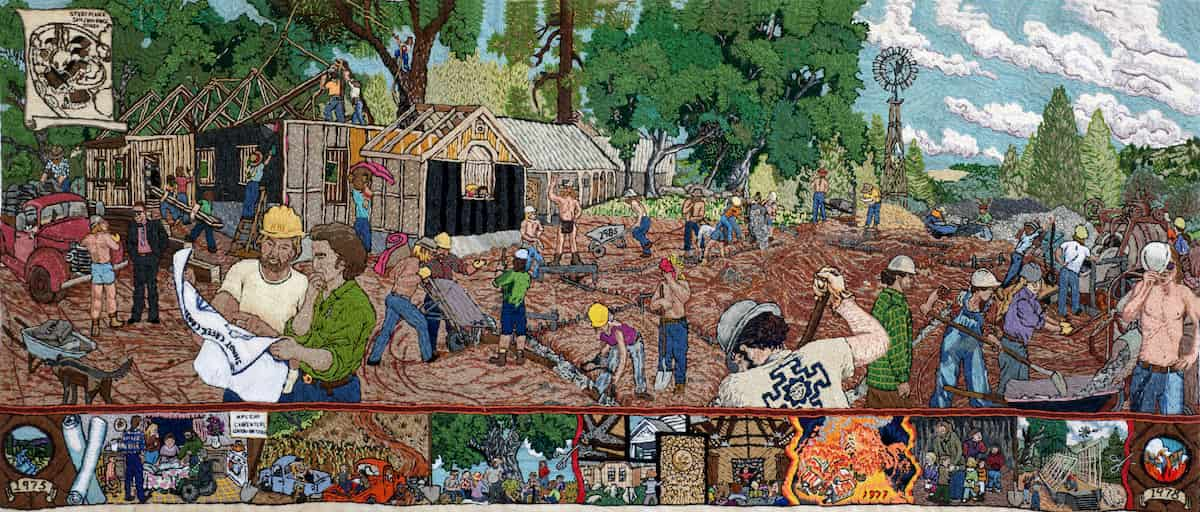
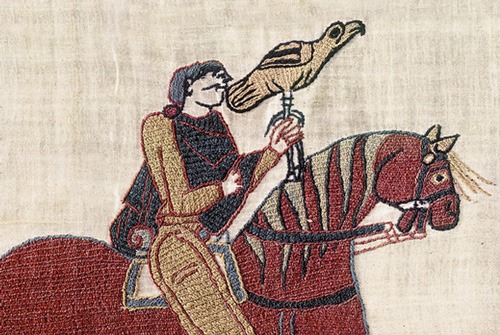
The Makers
Behind the intricate threads and vibrant patterns of the San Juan Ridge Tapestry are skilled artisans, craftsmen, and creative minds. Their dedication and expertise come together to weave a rich narrative that reflects the essence of our community. Meet Them!
The Inspiration
Our inspiration is the Bayeux Tapestry created soon after the invasion of England by William the Conqueror in 1066 . Our materials match those used in the tapestry, fine linen fabric and woolen yarns. We also have a lower border which elaborates on the theme in the central area. Our tapestry is long and narrow like the Bayeux Tapestry but broken into sections that fit the spaces on the wall of the Cultural Center. https://www.bayeuxmuseum.com/en/the-bayeux-tapestry/






